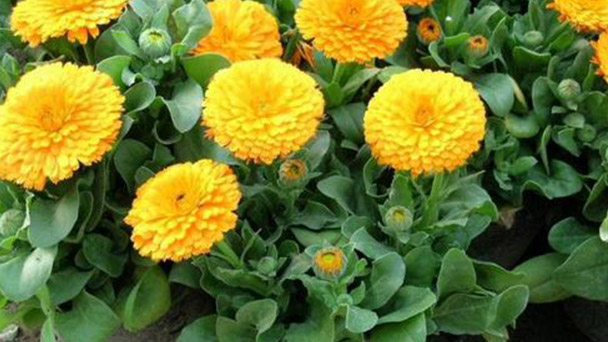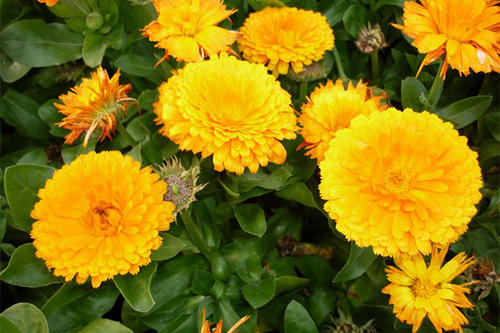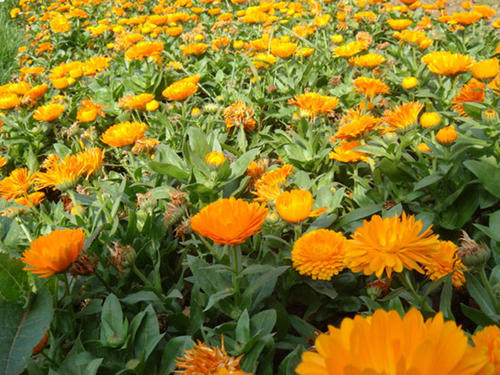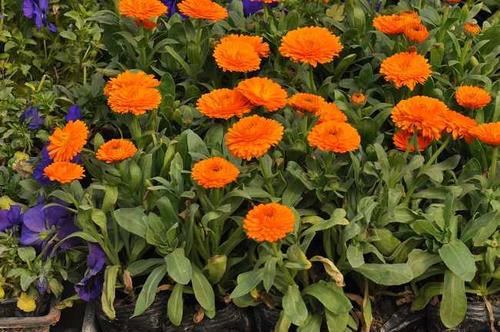Calendula Officinalis profile
Written by Maggie
Nov 24 2020

Calendula Officinalis is one of the most common herbal flowers in early spring gardens and cities. Calendula Officinalis leaves and petals are edible and thus can be used as a decoration for dishes.
Calendula Officinalis picture

Calendula Officinalis morphological characteristics
Calendula Officinalis is a biennial herb that is hairy throughout the plant. Leaves are alternate, oblong.
Inflorescences are solitary, flowers 5 cm in diameter, yellow, orange, orange-red, white and other colors. There are also double petals, roll petals and green heart, deep purple heart and other cultivars. The whole plant ca. is 20 ~ 75 cm tall, usually branched from base of stem, green or more or less glandular pilose.Basal leaves are oblong-ovate or spatulate. Inflorescence is a single stem terminal, 4 -- 5 cm in diam., involucral bracts 1 -- 2, lanceolate or oblong-lanceolate, outer layer slightly longer than inner layer, apical acuminate, florets yellow or orange yellow, longer than 2 times of involucral bracts, tongue up to 4 -- 5 mm wide. Corms of tubular flowers are with triangular lanceolate lobes, achenes all curved, light yellow or light brown, outer achenes mostly curved inside, often with small acupuncture points outside, tip beaked, both sides with wing ridges with regular horizontal creases. The flowering period is From April to September, and the fruiting period is from June to October.
Calendula Officinalis growth habits
Calendula Officinalis is a Calendula Officinalis native to southern Europe and the Coast of the Mediterranean, and prefers a mild, cool climate, and tolerates heat and cold. Calendula Officinalis requires adequate light or light shade, loose, good drainage, soil fertility moderate soil quality, a certain drought tolerance.The pH of the soil should be maintained at 6 ~ 7, so that the plants are much branched and the flowers are large and dense.
Temperature conditions
The optimal temperature for growth of Calendula Officinalis is 7 ~ 20℃, seedlings can withstand low temperature of -9 ℃ in winter, and adult plants should be 0℃.Too low temperature need to add film protection, otherwise the blade is vulnerable to freezing damage.The calendula officinalis grows in winter when the temperature is above 10℃. In summer when temperature increases, stems and leaves grow exuberant, flowers become smaller, petals significantly reduced. Calendula officinalis is good for the growth of stem and leaves and improves the cold resistance in winter. Adult plants with slightly dry advisable, and can control stem leaf to grow, lest cause to grow in vain.

Light conditions
Calendula Officinalis tolerates cold, afraid of heat, and enjoys a sunny environment, especially in winter open field seedling cultivation or shed cultivation, which requires sufficient sunshine, which is very beneficial to the growth of stems and leaves, and the growth of seedlings is short, strong and orderly .If encounter too much rain and snow day, insufficient light, base leaf is easy to become yellow, even root rot dies.
Calendula Officinalis distribution range
Calendula Officinalis is native to Europe, where it has been grown for a long time.The Chinese Calendula Officinalis was cultivated after being introduced from abroad in the 18th century. Calendula Officinalis has been produced in the suburbs of Shanghai during the Reign of Emperor Qianlong in the Qing Dynasty. After 1949, Calendula Officinalis was widely cultivated in gardens and used for potted ornamentals and flower-bed arrangement. After the introduction of double petals, large flowers and dwarf Calendula Officinalis to China in 1980, it has become one of the important herbal flowers in China.
Calendula Officinalis method of reproduction
Calendula Officinalis mainly USES seed reproduction. Seeds are usually sown in autumn or early spring greenhouses, with 100 ~ 125 seeds per gram, and the appropriate temperature for germination is 20 ~ 22℃. The soil in the basin should be disinfected. After sowing, the soil should be covered with 3 mm soil, and the germination takes 7 ~ 10 days.The germination rate was 80% ~ 85%, and the germination period was 2 ~ 3 years.

Latest Updated
- Benefits of Bugleweed - 7 Science-backed Health Benefits
- Bugleweed Dangers & Side Effects - Is It Poisonous?
- How to Plant Evergreen Trees - What You Should Know
- When to Plant Evergreens - Grow Guide for Evergreen Trees
- 12 Wonderful Evergreen Shrubs for Your Garden
- 12 Popular Evergreen Plants with Pictures for Beginners
- When And How To Prune A Lilac Bush Like a Pro
- How to Grow & Care for Lilac Vine (Hardenbergia Violacea)
- Japanese Lilac Tree (Syringa Reticulata) Care & Propagation Guide
- Shumard Oak Pros and Cons - What to Know
Popular Articles
- Winter maintenance of Antirrhinum Majus
- How to Grow Terminalia Mantaly Tree
- How to Grow and Care for Crossostephium Chinense
- How to grow Antirrhinum Majus in spring
- Peristeria Elata (Dove Orchid) Profile: Info & Care Guide
- Underwatered Snake Plant (Sansevieria Trifasciata) - Signs And How To Fix
- How to Care for Brazilian Jasmine Plant (Mandevilla Sanderi)
- How to Grow & Care for Graptopetalum Purple Delight in Summer
- Rosa Chinensis (China Rose): Plant Growing & Care Tips
- How to Care for Baby Sun Rose (Aptenia Cordifolia)